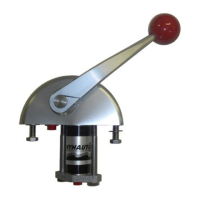Page 11 of 36 Pages
Install Tubing Between Senders and Slaves
(See Pages 22-27 for Plumbing Circuits)
1. Locate the tubing roll in a convenient location.
2. Starting at the highest control station, begin running tubing
from the upper tubing port of the right most sender to its
connecting point as shown on the diagram.
NOTE
Tubing may be run from the sender to connect-
ing point or from connecting point to sender,
whichever is easier.
3. Secure each end of the newly run tube by Inserting the
tube end assembly into the proper adapter (#530175), pre-
viously installed in components. Tighten down only until
there is firm resistance felt on the wrench.
4. Run the tubing from the lower port of the same sender,
repeating the previous steps.
5. Progress leftward across the control panel until all lines
have been run and secured. Then go to the next lower station
and run tubing from it in the same manner as it was from the
upper station.
6. If the boat has more than two stations, continue running
tubing from them in the same manner, still following the
tubing diagram.
7. At this point all tubing should be run and connected. Now,
secure tubing using ties and clamps. This should be done
prior to filling the system.
NOTE
When securing tubing with clamps, do not
over- tighten clamps or ties, as overtightening
will crimp the tubing causing poor
system operation.
5. The system will now begin to fill with fluid. As the system
fills the fluid level in the reservoir will become lower. When
the fluid level is between 1 to 2 inches from the bottom of the
sight glass release the pressure and refill the tank, as in Step
4.
6. Repressurize the system and repeat this procedure of
filling the reservoir as required until no fluid drop is noted. At
this point, the system is filled and must now be bled.
7. Check entire system for leaks and correct as required.
Bleeding the System at Slave
NOTE
The bleeding procedure is much easier for two
people to perform than one. (One to keep the
reservoir filled and under pressure, while the
other one bleeds the system.)
1. Fill the reservoir as required.
NOTE
Verify that linkage is disconnected, and
sender’s handles are free to move.
While bleeding, move the slave arm and verify
that the piston has bottomed.
2. Using the bleeder tube provided and a clean, empty
container, insert the bleeder tube in the bleeder valve at one
side of a slave. Open the bleeder valve about one turn and
bleed system until no air bubbles are evident in the flowing
fluid. When the fluid is clear, close the bleeder valve. During
the bleed operation maintain the system pressure above 60
psi, and the fluid level in the sight gauge above the two-inch
mark. Should the fluid level drop below two inches close the
bleeder valve and release the pressure from the system.
Refill the reservoir with the fluid that has been bled off,
repressurize the system and continue bleeding. Bleed long
enough that no air or foam remains in this branch of the
system. Draw at least a full reservoir of fluid thru each side
of each circuit.
NOTE
Since there are two positions at each slave to
be bled and four slaves, the reservoir must be
filled at least 8 times during the bleed opera-
tion. The fluid which has been bled off should
be used to refill the reservoir.
3. Tighten bleeder valve after the bleed operation.
4. Bleed the second port of the slave as described in Steps
1, 2, and 3.
5. Repeat steps 1 thru 4 with a second person at the sender
moving the handles back and forth slowly five to ten times
6. Continue performing the preceding five steps for each
remaining slave.
Filling and Bleeding System
Filling the System
1. Verify that all sender arms are free to traverse their
complete arc.
2. Verify that all bleeder valves on the throttle and clutch
slaves are closed, and linkages disconnected.
IMPORTANT NOTE
See section on“System Fluid” for fluid speci-
fications on Page 10.
3. Remove fill port plug from the reservoir and fill the
reservoir within one inch of the top of the sight tube with
MCO-03 water glycol fluid. Replace fill port plug.
4. Pressurize reservoir to 100 +/-10 psi through the air filler
valve in the top of the reservoir.

